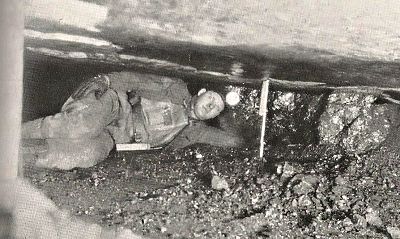NORTHERN ALABAMA COALFIELDS (INCLUDING GEORGIA)
Depending on who you talk to, there are five bituminous coalfields in Alabama:
CAHABA COALFIELD (St. Clair, Jefferson, Shelby, and Bibb Counties)
COOSA COALFIELD (St. Clair and Shelby Counties)
LOOKOUT MOUNTAIN COALFIELD (Dekalb, Cherokee, & Etowah Counties; and Dade, Walker, & Chatooga Counties, GA)
SAND MOUNTAIN COALFIELD (Jackson, Dekalb, Etowah, Marshall, and Blount Counties)
WARRIOR COALFIELD (Jefferson, Tuscaloosa, Fayette, Walker, Winston, and Marion Counties)
This poor guy was working in 20" of Black Creek Seam coal, although he doesn't
look particularly unhappy about it. Photo was taken in the Bradford Mine of the Alabama By-Products Corp.
The old portal from the Eureka No. 3 coal mine in the Cahaba Coalfield.
Ruins of the tipple at Brookside, AL.
Ensley, Alabama coal camp houses. Ensley was developed in the late 19th Century by the Tennessee Coal, Iron and Railroad Company.
Former Birmingham Coal and Iron Company store in Mulga, AL, with separate enterances for the meat market, grocery, and dry goods sections. This Warrior Coal Field mine was
a shaft mine harvesting coal from a 5' thick section of the Pratt seam. An explosion in 1937 in the Woodward Iron Company's coal mine at Mulga killed 33 men.
Former coal camp house in Mulga, AL.
Slate dump left over from the Pratt Mine in Birmingham. This coal mine gave its name to the famous Pratt coal seam, which is a great metallurgical coal.
Company houses at Docena, AL. The Docena coal mine was a shaft mine down into the Pratt coal seam, and was served by the Birmingham Southern Railroad.
Coal miners in Birmingham, Alabama, circa 1944.
Coal mine ruins at Sayre, AL.
Coal company houses in Praco, Al.
From a December 11, 1981 UPI article titled, "Coal Co. Town to Close Its Doors, Evict Residents" -
The small community of Praco, the last company-owned coal town in Alabama, will vanish next month. The deteriorating community northwest of Birmingham is shutting down, its residents having ben told by
Alabama By-Products that they must find new homes within 30 days. About 80 houses remain, not all of them occupied. The number of people affected isn't known ... "These are the last of some 500 houses that we owned in that
area," said Gene W. Lewis, president of Alabama By-Products. "The primary purpose of these houses many, many years ago was for our employees. It's not a cold-hearted decision, but was one made quite some time ago. We are
not in the housing business but in mining." The company store closed last June, and the company has notified the remaining residents that they must vacate. Many of the residents do not look at Praco's closing with nostalgia,
but with anger and worry. "I would like to stay. It is about the only place where I can afford to rent," said Mrs. Billie Pridemore, a Praco resident for 26 years.
LOOKOUT MOUNTAIN COALFIELD IN GEORGIA
The Lookout Mountain Field extends into Dade, Walker, and Chatooga Counties Georgia. This is the
only area of Georgia where bituminous coal mining has occurred. The coal is a low-volatile coal of a high quality. The thickness of the
coal seams varied widely. At one point the Dade seam was 17' thick. The Durham seam averaged 38", but could thicken out to 84"
in some places.
Portal into the coal mine of the Durham Coal & Coke Company in Walker County.
The Cherokee Indians were driven out of the area on the Trail of Tears in the 1830's. That "cleared" (for lack of a more sensitive term) the
way for industrialists to come in to the area and develop the coal resources. This is an area where
the Appalachian culture is morphing into the Deep South culture, and so it is no suprise that black convicts supplied some of the
labor force. Coal mines near Durham, GA had started operating before the Civil War.
Evidently, Durham later evolved into a Durham Coal & Coke Company town, with company housing, company store, and even company-built churches. Durham
Coal & Coke shipped their first coal in 1892. Coal was mined at
Durham off and on until the 1940's.
In the late 19th and early 20th Centuries coal was coked at Chickamauga, GA, and a portion of the beehive coke ovens (built with convict labor) survives to this day.
The market for the coke was the iron furnaces and foundries in Chattanooga, TN.
During the coal boom of the 1970's strip mining extracted a good bit of coal, as was happening over most of the Appalachian Coal Basin at
the time.
Incline at the Georgia Iron & Coal Company's Raccoon mine in Dade County.
Old air shaft to a deep mine near Cole City, Dade County, Georgia.


Circa 1938 American Mining Congress image

Image courtesy of Backroads Driver

Public domain image by David Diesing, Historical American Engineering Record

Google Street View image

Public domain image by Jet Lowe, Historical American Engineering Record

Public domain image by Jet Lowe, Historical American Engineering Record

Public domain image by Jet Lowe, Historical American Engineering Record

Image source forgotten

Image by Arthur Rothstein, FSA/OWI Collection, Library of Congress

Bing maps image

1970s image courtesy of Patricia Dickey Whitlock via al.com


Geological Survey of Georgia image via Google Books

Geological Survey of Georgia image via Google Books

Jan. 2009 image by Ken & Becky Pennington
